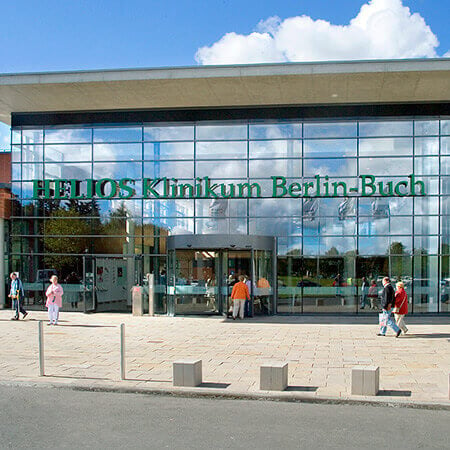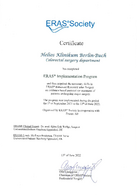Colostomy Closure for Rectal Cancer treatment in the Best Hospitals in the World
Treatment prices are regulated by national law of the corresponding countries, but can also include additional hospital coefficients. In order to receive the individual cost calculation, please send us the request and medical records.

Department of General, Abdominal Surgery and Surgical Oncology
The Department of General, Abdominal Surgery and Surgical Oncology offers the full range of services in these medical fields. Whenever possible, operations are performed using minimally invasive techniques, which are the gold standard of modern surgery. The outstanding quality of medical care is confirmed by numerous prestigious certificates, including certificates from the German Cancer Society, the German Hernia Society, etc. In addition, the department provides innovative hyperthermic intraperitoneal chemotherapy (HIPEC), which is available only in the most progressive clinics in Europe.







Department of General, Endocrine and Bariatric Surgery
The Department of General, Endocrine and Bariatric Surgery offers the full range of operations to treat surgical diseases of the gastrointestinal tract and abdominal cavity, diseases of the rectum, anus and colon, as well as pathologies of the endocrine organs. In addition, the department specializes in the surgical treatment of morbid obesity. The team of bariatric surgeons successfully performs the most effective weight loss surgeries – gastric bypass surgery and sleeve gastrectomy. The key focus in clinical practice is on the surgical treatment of malignancies of the gastrointestinal tract, colorectal cancer and inflammatory bowel diseases. The surgical interventions are performed in progressive operating rooms equipped with state-of-the-art medical technologies, which guarantee the patient the most sparing treatment in compliance with all hygiene and safety standards. The department's surgeons are distinguished by rich clinical experience and exceptional qualifications. They regularly undergo internships in the best medical facilities in Europe and the United States, thanks to which they brilliantly perform operations of any complexity.




Department of General and Abdominal Surgery, Colorectal Surgery, Hepatopancreatobiliary Surgery, Hernia Surgery and Bariatric Surgery
The Department of General and Abdominal Surgery, Colorectal Surgery, Hepatopancreatobiliary Surgery, Hernia Surgery and Bariatric Surgery provides the full range of surgical treatment in its field of competence. The department's highly qualified surgeons annually perform about 2,000 surgical interventions. Extensive clinical experience allows the specialists to perform even particularly complex operations. The department’s advanced operating rooms serve for surgery to treat gastrointestinal diseases, liver, gallbladder, bile duct, pancreatic, rectal, anal and colon pathologies. The medical facility also successfully performs operations to treat hernias: inguinal, umbilical, and anterior abdominal wall hernias. In addition, the department's doctors deal with the surgical treatment of morbid obesity. Minor traumatic laparoscopic interventions are considered the gold standard, which guarantee a patient minimal risks and rapid postoperative restoration. Surgeons tell the patient in detail about their upcoming treatment and, in every possible way, support them in their recovery.






Colorectal cancer is a cancer of the colon, sigmoid, and rectum. Most colorectal cancers start with small, benign tumors called adenomatous polyps and adenomas. Over time, some of these polyps can transform into a malignant tumor.
Symptoms of colorectal cancer
Colorectal cancer symptoms depend on the stage and location of the tumor. However, similar symptoms can be observed with other diseases. An important fact is that often symptoms only appear at the advanced stages of cancer.
The most common symptoms are:
- Blood in the stool
- Stool changes (diarrhea or constipation)
- Stomachache
- Losing weight
- Weakness, fatigue
However, none of these symptoms indicates specifically colorectal cancer. For example, blood in the stool can occur with hemorrhoids, and bowel infection can cause diarrhea.
If the bleeding is caused by colorectal cancer, it can continue for many months. In this case, the person may not even notice the blood loss, and the patient's main complaints might be shortness of breath, fatigue, and dizziness, which are the symptoms of anemia.
When the tumor increases in volume, it can completely block the intestines. In this case, a blockage or significant narrowing of the intestines complicates the movement of stool and intestinal gases, so bloating occurs.
Diagnostics
Patients with suspected colorectal cancer need urgent diagnostics.
Endoscopy, which is called colonoscopy in regards to bowel examination, is the main test for diagnosing colorectal cancer.
This is an outpatient procedure during which the rectum and colon are examined from the inside using a special probe (endoscope). The colon is expanded with a small amount of air so that the doctor can examine the tissues lining it (the image can be seen on the monitor). If a part of the intestine needs to be examined more thoroughly, instruments are inserted through the endoscope for a painless biopsy. These tissues are sent to a laboratory for analysis. Microscopic analysis of tissue is essential for correct diagnosis making and staging of colorectal cancer.
Another method of examination, sigmoidoscopy, allows doctors to examine the lower third of the colon, rectum, and sigma. If diagnostic imaging tests indicate that a more detailed examination is needed, a colonoscopy with biopsy should be performed.
A barium enema can also be used for the diagnostics of colorectal cancer. A barium enema (or air-contrast barium enema) is an X-ray technique used to produce an image of the colon. Two days before the examination with a barium enema, a patient should consume a light, mostly liquid food, and in the evening before the examination a laxative should be taken. On the day of the examination a barium enema is administered, the air is inflated into the colon and an X-ray of the abdomen is carried out.
It is very important to differentiate colorectal cancer from Crohn's disease and severe ulcerative colitis (it should be noted that both diseases are connected with a risk of the colorectal cancer development).
In the case of severe ulcerative colitis, general inflammation of the mucous membrane, edema, fragility of the mucous membrane with hemorrhages are noted. In Crohn's disease, repeated cycles of ulceration, followed by periods of healing, occasionally cause areas of the mucous membrane to lift up, resulting in the formation of the polyps-like formations called pseudo polyps. A characteristic feature of Crohn's disease during the endoscopic examination is the typical appearance of a mucous membrane similar to a cobblestone pavement.
Colostomy overview
A doctor form a colostomy in following health conditions:
- The large intestine is blocked or damaged
- A part of the large intestine is surgically removed
- A ruptured colon causes an abdominal infection
- Colostomy might be needed after rectal cancer surgery
People with certain types of cancer, such as colorectal cancer, may need a colostomy. Most people who need a cancer-related colostomy only need it for a few months, while the colon or rectum heals.
A colostomy is also performed in the following pathologies:
- Colon polyposis
- Disorders of the structure and functioning of the intestine
- Nonspecific ulcerative colitis
- Intestinal obstruction
- Acute diverticulitis
- Crohn's disease
An intestinal stoma is an artificially formed connection between the intestine and the surface of the skin. There are two main types of stomas: ileostomy and colostomy. The ileostomy is formed from a loop of the small intestine, while a fragment of the large intestine is used for a colostomy.
After a colostomy, the patient does not feel the urge to bowel evacuation and does not control the process, and feces and intestinal gases are released spontaneously. The contents of the intestines are collected in an airtight, odor-proof bag called a colostomy bag. Colostomy bags are also designed to protect the skin surrounding the stoma. These bags are disposable and reusable, they are not visible under clothing and do not cause discomfort.
In most cases, colostomy, in other words, the creation of an artificial anus, is prescribed for cancer of the large intestine or rectal cancer. The procedure is not indicated for all patients who have undergone surgery for rectal cancer treatment. When elaborating a treatment protocol, factors such as the location and size of the tumor, the degree of damage to nearby tissues, and the general health state of the patient are taken into account.
Besides, the colostomy surgery is indicated when the condition of the intestine is unsatisfactory for carrying out a conventional surgery. In addition, in many cases, doctors face a serious health state of a patient who has been admitted to the hospital. In order to alleviate symptoms and save the patient's life, it is necessary to create the intestinal stoma.
The successful operation of creating the stoma requires high qualifications and experience from the surgeon.
Complications of colostomy
The most common complications include:
- Peristomal dermatitis. Peristomal dermatitis manifests itself in irritation of the skin surrounding the stoma, hyperemia, the appearance of ulcers, pain, and burning sensation.
- Bleeding from the stoma. Bleeding from the stoma is usually caused by the injury to the intestinal mucosa due to improper care. Usually, bleeding stops soon without special treatment, but prolonged bleeding requires immediate medical attention.
- Purulent inflammation of the tissues surrounding the stoma.
- Necrosis of tissues adjacent to the stoma.
- Narrowing (stenosis) of the stoma. Until the narrowed intestinal stoma does not interfere with the excretion of feces and does not cause the patient any pain, stenosis is considered normal.
- Stoma retraction.
- Stoma prolapse.
With the loss of a larger segment of the intestine, the excretion of the contents of the intestine is hampered, and care becomes more complicated. The prolapse worsens when the patient stands, coughs, or exerts any physical effort.
A colostomy can be temporary or permanent. A temporary colostomy is more common. The main indications are pelvic trauma, complicated intestinal obstruction, stoma in rectal cancer, ulcerative colitis, Crohn's disease, intestinal polyposis.
A temporary stoma is formed during the primary surgery for rectal cancer treatment, followed by the reversal colostomy. Subsequently, bowel function is fully restored.
In some cases of colorectal cancer, when anal bleeding or acute obstruction is observed, permanent colostomy is performed. Surgeons choose such measures in the presence of indications, when a reconstructive surgery is impossible for one or another reason.
Colostomy closure
Reversal colostomy is a surgery that closes the intestinal stoma (artificial anus) and normalizes bowel function. The modern equipment and high level of training of the surgeons allow successfully carrying out this type of reconstructive surgery.
Removal of the stoma is considered the final stage of surgical rectal cancer treatment. It follows the surgery for artificial opening creation that is formed to empty the bowel.
Colostomy closure is often performed after the surgical removal of colorectal cancer. This usually happens 4-6 months after the first rectal cancer surgery. The period length may vary depending on the patient's health state.
The presence of an unnatural intestinal opening often causes physical and moral discomfort in patients. It is clear that reversal colostomy and restoration of normal bowel function is extremely important for patients.
On average, a reversal colostomy is performed 3-4 months after the formation of a temporary stoma, when the person has fully recovered from the first surgery. This period can be lengthened if there is inflammation in the abdominal cavity, complications, and relapses of rectal cancer. In such cases, additional measures are taken to restore the functioning of the non-working part of the intestine.
During reversal colostomy, anesthesia is used. To close a temporary stoma, surgeons remove the stitches from the surfaces and spread the stoma to the sides.
After connecting parts of the intestine, surgeons evaluate the quality of stitches before finishing reversal colostomy. Reconstruction of the large intestine and restoration of natural bowel movement depend on the length of the disconnected area, the presence of adhesions, inflammation, and other factors.
The reversal colostomy surgery is considered a very complex surgery in proctology. It requires a satisfactory health state of the patient and a highly qualified surgeon.
When deciding to carry out this surgery, certain factors are taking into consideration, including:
- Life expectancy prognosis in rectal cancer patients
- Absence of pathologies (cancer tumors, inflammation)
- Absence of severe side effects after colostomy
The patient should be informed in detail about the complexity of this surgery, the risk of postoperative complications, and the expected results of the surgery.
Where can I undergo colostomy closure for rectal cancer treatment abroad?
The best success rates in reversal colostomy are demonstrated by:
- Academic Hospital Brothers of Charity Munich, Germany
- University Hospital of Ludwig Maximilian University Munich, Germany
- Charite University Hospital, Germany
- University Hospital Ulm, Germany
- Tel Aviv Sourasky Medical Center, Israel
- Medipol Mega University Hospital Istanbul, Turkey
You can check out the full list of hospitals on the Booking Health website.
The cost of rectal cancer treatment with colostomy closure
The prices in hospitals listed on the Booking Health website are relatively low. With Booking Health, you can undergo rectal cancer treatment in the best hospitals in the world at an affordable price.
The cost varies, as the price for treatment depends on the hospital, the diagnosis, and the complexity of treatment:
- The price for treatment in Germany is from 16,727 EUR to 26,157 EUR
- The price for treatment in Israel is approximately 14,400 EUR
- The price for treatment in Turkey is approximately 8,300 EUR
The final cost may differ from the prices mentioned above. To make sure that the price for treatment is suitable for you, contact us by leaving the request on the Booking Health website.
How can I undergo colostomy closure in the best hospitals in the world?
It is not easy to choose the right hospital that ensures successful colostomy closure surgery. It is vital to have accurate information on the success rates in rectal cancer treatment of the specific hospital.
We have up-to-date information on rectal cancer treatment in the best hospitals in the world. You can be free of unnecessary troubles, while Booking Health takes care of all organizational issues. Our goal is to find the best facility for rectal cancer treatment for you.
We may help you during this difficult period and take on all the troubles. Booking Health will select a hospital, taking into account your wishes and the indications for rectal cancer treatment.
Rectal cancer can be treated! The earlier you start the treatment, the higher the chances of returning to your day-to-day life. All you need to do is to leave the request on the Booking Health website and our manager will contact you shortly.

